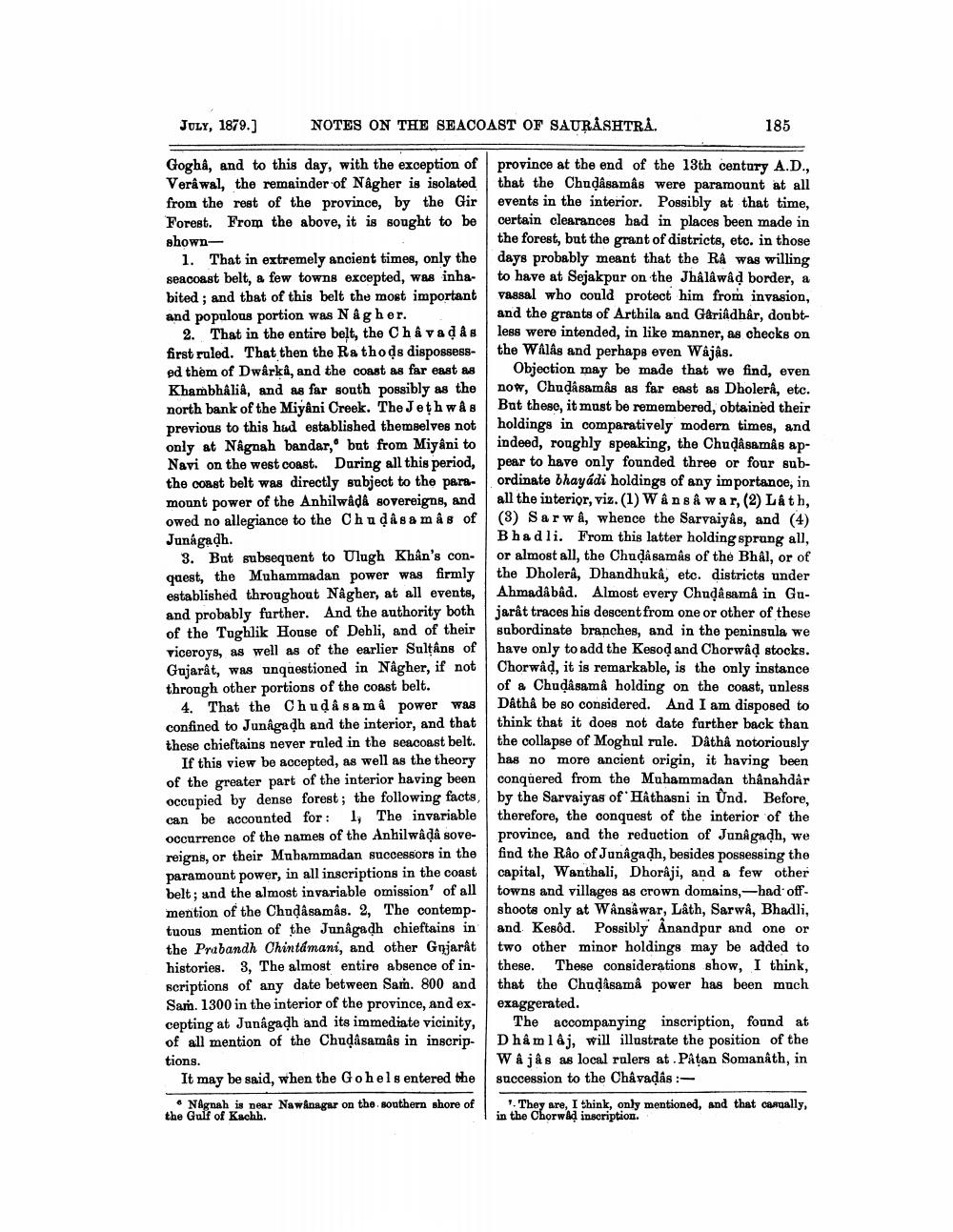________________
JULY, 1879.)
NOTES ON THE SEACOAST OF SAURASHTRÅ.
185
Gogha, and to this day, with the exception of Verâwal, the remainder of Nâgher is isolated from the rest of the province, by the Gir Forest. From the above, it is sought to be shown
1. That in extremely ancient times, only the seacoast belt, a few towns excepted, was inhabited, and that of this belt the most important and populous portion was Nagher.
2. That in the entire belt, the Chå vad ås first ruled. That then the Rathods dispossessed them of Dwarkâ, and the coast as far east as Khambhâliâ, and as far south possibly as the north bank of the Miyâni Creek. The Jeth was previous to this had established themselves not only at Någnah bandar, but from Miyani to Navi on the west coast. During all this period, the const belt was directly subject to the para- mount power of the Anbilwâdå sovereigns, and owed no allegiance to the Chudasa más of Junagadh.
3. But subsequent to Ulugh Khan's conquest, the Muhammadan power was firmly established throughout Någher, at all events, and probably further. And the authority both of the Tughlik House of Debli, and of their viceroys, as well as of the earlier Sultans of Gujarât, was unqaestioned in Någher, if not through other portions of the coast belt.
4. That the Chudasama power was confined to Junagadh and the interior, and that these chieftains never ruled in the seacoast belt.
If this view be accepted, as well as the theory of the greater part of the interior having been occupied by dense forest; the following facts, can be accounted for: 1; The invariable occurrence of the names of the Anhilwaạå sove- reigns, or their Muhammadan successors in the paramount power, in all inscriptions in the coast belt; and the almost invariable omission of all mention of the Chudasamås. 2, The contemp- tuous mention of the Junagadh chieftains in the Prabandh Chintamani, and other Gujarat histories. 3, The almost entire absence of inscriptions of any date between Sam. 800 and Sam. 1300 in the interior of the province, and excepting at Junagadh and its immediate vicinity, of all mention of the Chudasamâs in inscriptions.
It may be said, when the Gohels entered the
Nagnah is near Naw&nagar on the southern shore of the Gulf of Kachh.
province at the end of the 13th century A.D., that the Chudasamâs were paramount at all events in the interior. Possibly at that time, certain clearances had in places been made in the forest, but the grant of districts, etc. in those days probably meant that the RA was willing to have at Sejakpur on the Jhâlâwâd border, a vassal who could protect him from invasion, and the grants of Arthila and Gariadhar, doubtless were intended, in like manner, as checks on the W Alås and perhaps even Wajâs.
Objection may be made that we find, even now, Chudásamas as far east as Dholera, etc. But theso, it must be remembered, obtained their holdings in comparatively modern times, and indeed, roughly speaking, the Chudåsamas appear to have only founded three or four subordinate bhayádi holdings of any importance, in all the interior, viz. (1) Wâns & war, (2) Láth, (3) Sarwa, whence the Sarvaiyâs, and (4) Bhadli. From this latter holding sprung all, or almost all, the Chudá samas of the Bhål, or of the Dholera, Dhandhuka, etc. districts under Ahmadabad. Almost every Chudasamâ in Gujaråt traces his descent from one or other of these subordinate branches, and in the peninsula we have only to add the Kesod and Chorwad stocks. Chorwâd, it is remarkable, is the only instance of a Chudasama holding on the coast, unless Dath be so considered. And I am disposed to think that it does not date further back than the collapse of Moghul rule. Dåthå notoriously has no more ancient origin, it having been conquered from the Muhammadan thânahdar by the Sarvaiyas of Hathasni in Und. Before, therefore, the conquest of the interior of the province, and the reduction of Junagadh, we find the Râo of Junagadh, besides possessing the capital, Wanthali, Dhoraji, and a few other towns and villages as crown domains, -had- offshoots only at Wånså war, Låth, Sarwâ, Bhadli, and Kesôd. Possibly Anandpur and one or two other minor holdings may be added to these. These considerations show, I think, that the Chudasama power has been much exaggerated.
The accompanying inscription, found at Dhå mlaj, will illustrate the position of the W å jâs as local rulers at. Påtan Somanath, in succession to the Chåvadás :
They are, I think, only mentioned, and that caually, in the Chorwad inscription.




